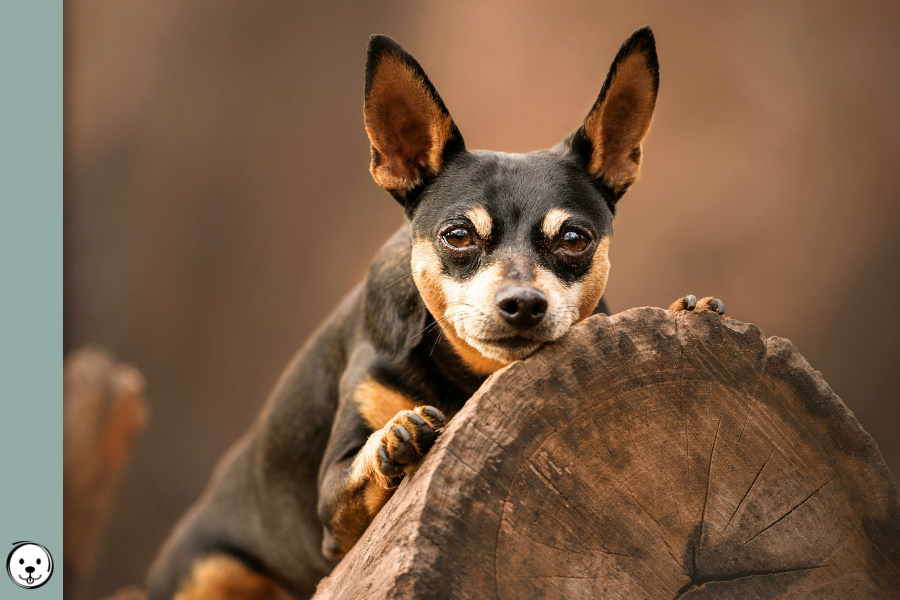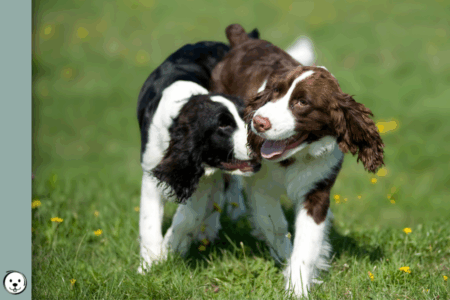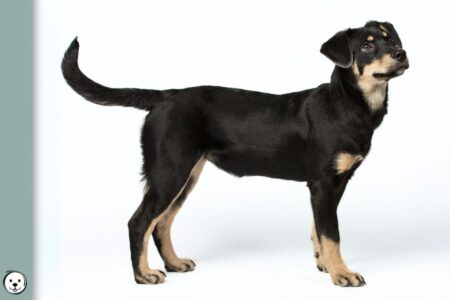Some dogs produce only eumelanin (black pigment) in their coat. Others produce only phaeomelanin (red pigment). But many dogs produce a bit of both pigments.
There is a wide range of possibilities for pigment distribution in the coat.
Learn what makes a pigment cell switch from one type of pigment to the other and how the E Locus, K Locus, and A Locus interact to create all the different base patterns in dogs.
Pigment Types
The melanocytes are melanin-producing pigment cells.
These “pigment factories” can produce either eumelanin or phaeomelanin.
Phaeomelanin is a red pigment. But red intensity can vary from off-white to red.
Eumelanin is a black pigment. But it can be modified to brown, blue, or lilac.
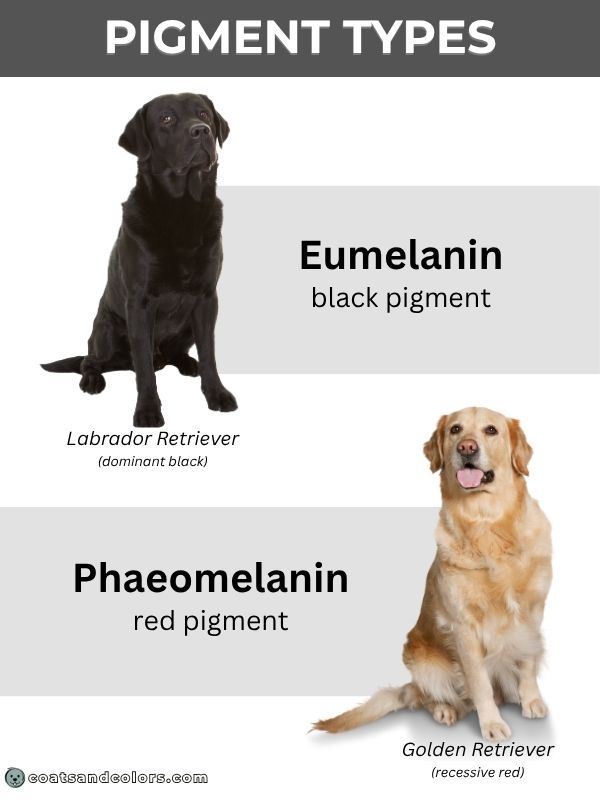
The Baseline
Pigment cells in the hair follicle produce phaeomelanin by default. Unless they are told otherwise.
In order to produce eumelanin, the pigment cells need a signal from outside the cell.
Pigment cells use the melanocortin 1 receptor (MC1R) in their membrane to receive these signals.
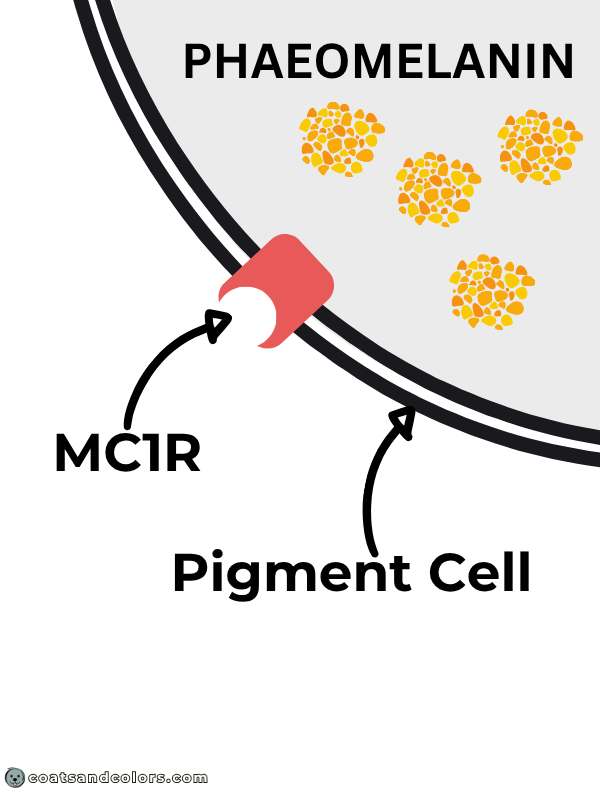
The pituitary gland and skin spontaneously secrete α-Melanocyte-stimulating hormone (α-MSH).
The α-MSH binds to MC1R and gives a permanent signal to switch from phaeomelanin to eumelanin.
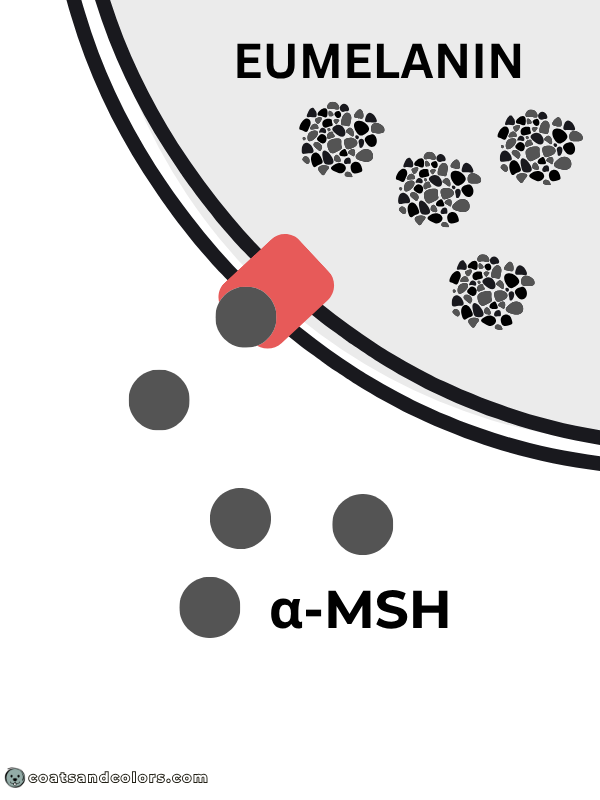
This gives us the baseline situation for the E locus:
- The pigment cells want to make phaeomelanin.
- But they get a permanent signal from α-MSH via MC1R interaction to make eumelanin.
The A Locus
The agouti locus or short A locus holds the building plan for agouti signalling protein or ASIP.
ASIP wants to bind to the melanocortin 1 receptor.
It does this so effectively that it blocks the access of α-MSH to the MC1R.
If ASIP is present, α-MSH cannot bind to MC1R, and the affected cells produce phaeomelanin.
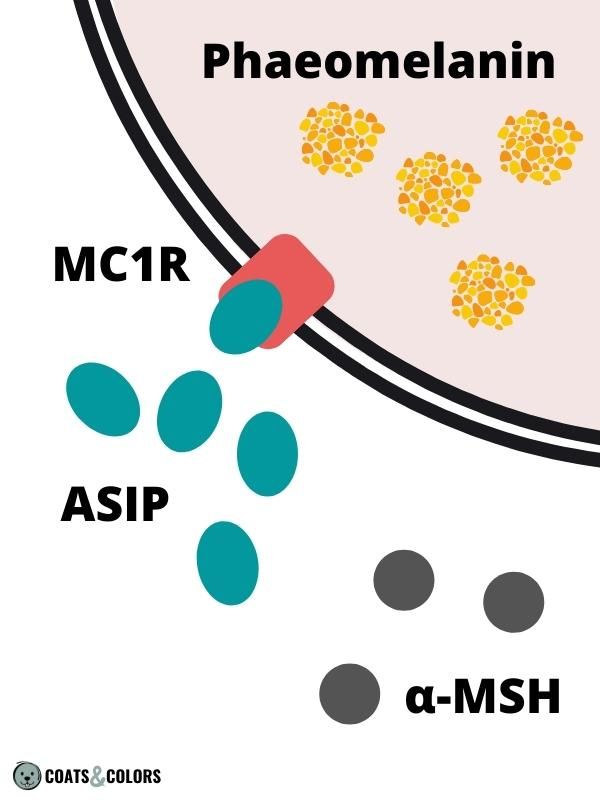
ASIP expression in different body parts is controlled by two promoter regions.
The hair cycle promoter (HCP) regulates ASIP expression on the upper body.
The wild-type HCP2 is expressed in intervals. This causes dorsal hair banding with alternating stripes of eumelanin and phaeomelanin. The more active HCP1 variant causes predominantly yellow hairs, some with darker tips (sabling). The less active HCP3,4,5 give solid black hairs, some with pale roots.
The ventral promoter (HCP) regulates ASIP expression on the lower body.
This promoter controls the extension of ventral tan markings. The wild-type VP2 gives classic tan points. The more active VP1 extends these tan markings onto the upper body.
The different alleles of the A locus represent promoter haplotypes and cause different basic patterns.
The order of dominance goes from more phaeomelanin to less phaeomelanin:
- Ay, clear sable (VP1-HCP1)
- extended ventral tan markings (VP1)
- extended dorsal tan banding (HCP1)
- Ays, shaded sable (VP2-HCP1)
- normal ventral tan markings (VP2)
- extended dorsal tan banding (HCP1)
- aw, agouti (VP2-HCP2)
- normal ventral tan markings (VP2)
- normal dorsal tan banding (HCP2)
- asa, saddle (VP1-HCP3,4,5)
- extended ventral tan markings (VP1)
- reduced dorsal tan banding (HCP3,4,5)
- at, tan point (VP2-HCP3,4,5)
- gives a predominantly black coat with wild-type tan points.
- normal ventral tan markings (VP2)
- reduced dorsal tan banding (HCP3,4,5)
- a is a loss-of-funtion mutation that disables ASIP. It causes recessive black since α-MSH now regains the competitive advantage and can bind to MC1R and activate the production of eumelanin.
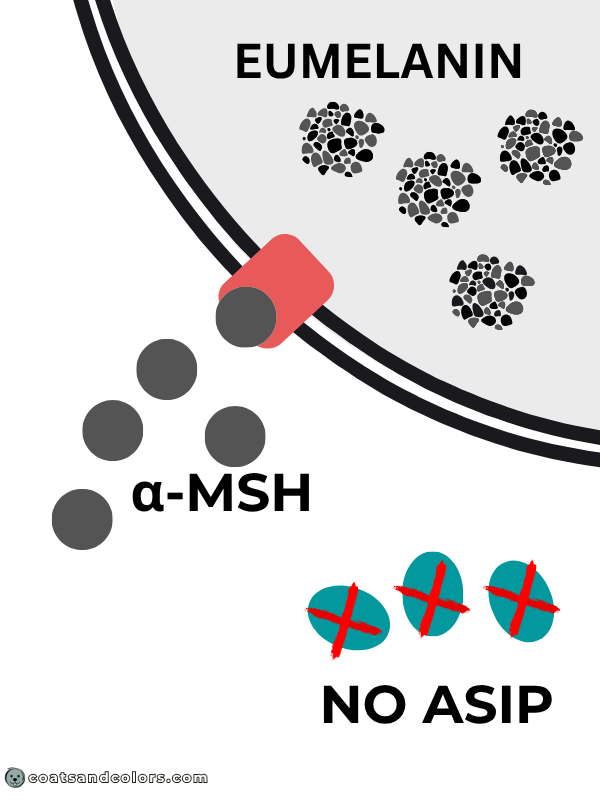
The K Locus
The DEFB103 gene at the K locus encodes the building plan for β-Defensin 103 (CBD103).
This protein is normally part of the innate immune response system of the skin.
In dogs, there is a mutated version of the β-Defensin 103 known as the KB allele.
The KB gene product binds to MC1R and blocks both ASIP and α-MSH from binding to MC1R[1]
The presence of KB promotes eumelanin production.

There are three gene variants at the K locus.
The order of dominance goes from more eumelanin to less eumelanin:
- KB is the dominant allele in this series and causes dominant black. KB masks the A locus pattern since it blocks the access of ASIP to the receptor. An unknown trait can cause incomplete dominant black which enables tan showing through in some KB dogs anyway. This causes a ghost pattern phenotype.
- kbr is a structural variant with both KB and ky elements. The KB elements can only partially interrupt the access of ASIP and cause a brindle pattern with irregular black stripes on top of the A locus pattern.
- ky is the wild type and does not block ASIP, so it doesn’t interfere with coat colors.
The E Locus
The alleles of the E locus each build a slightly different version of the melanocortin 1 receptor.
The order of dominance goes from more eumelanin to less eumelanin:
- Em is the dominant allele in this series. It produces a melanistic mask on top of any base pattern. We don’t know why this is mainly limited to the muzzle or how exactly this works.
- E is the wild-type allele and just enables normal base pattern expression. It can properly receive signals both from the A locus and K locus.
- eG (Grizzle Domino), eA (Northern Domino), and eH (Cocker Domino) are reduced-function alleles with a limited ability to trigger eumelanin synthesis. This causes a domino phenotype with a pale undercoat and extended areas of phaeomelanin. Domino alleles can be described as “partial recessive red“. They severely reduce (but don’t fully remove) the functionality of MC1R.
- e is a loss-of-funtion mutant that basically deactivates MC1R[2]. This causes a solid recessive red phenotype in all pigmented areas. Homozygous e/e dogs can not build a functional receptor. The pigment cells consequently remain locked in their default setting to only produce phaeomelanin.
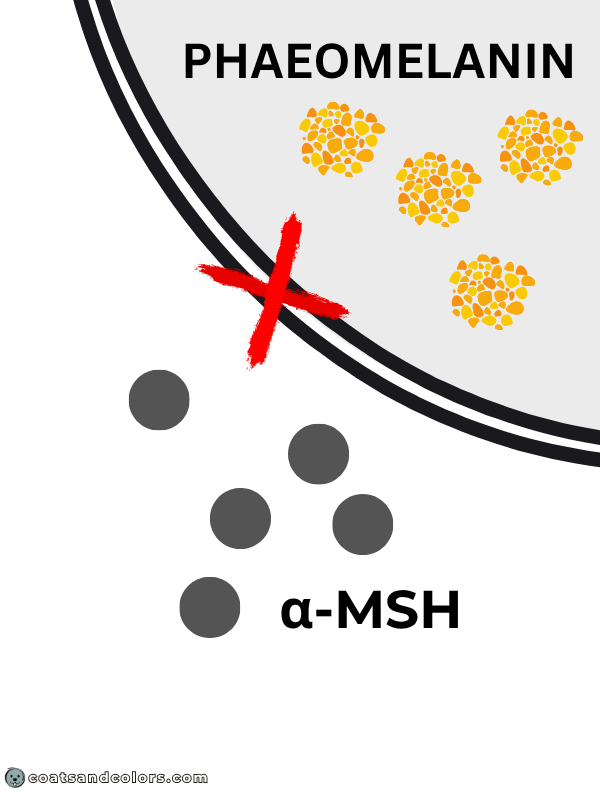
Summary
A quick overview on how genes interact in different combinations:
| E | K | A | Phenotype |
|---|---|---|---|
| Em/- | KB/- | – | Dominant Black |
| Em/- | kbr/- | Ay/- | Sable + Mask + Brindle |
| Em/- | kbr/- | Ays/- | Shaded Sable + Mask + Brindle |
| Em/- | kbr/- | aw/- | Agouti + Mask + Brindle |
| Em/- | kbr/- | at/- | Tan Point + Mask + Brindle |
| Em/- | kbr/- | asa/- | Saddle Pattern + Mask + Brindle |
| Em/- | kbr/- | a/a | Recessive Black + Mask |
| Em/- | ky/ky | Ay/- | Sable + Mask |
| Em/- | ky/ky | Ays/- | Shaded Sable + Mask |
| Em/- | ky/ky | aw/- | Agouti + Mask |
| Em/- | ky/ky | at/- | Tan Point + Mask |
| Em/- | ky/ky | asa/- | Saddle Pattern + Mask |
| Em/- | ky/ky | a/a | Recessive Black + Mask |
| E/- | KB/- | – | Dominant Black |
| E/- | kbr/- | Ay/- | Sable + Brindle |
| E/- | kbr/- | Ays/- | Shaded Sable + Brindle |
| E/- | kbr/- | aw/- | Agouti + Brindle |
| E/- | kbr/- | at/- | Brindlepoint |
| E/- | kbr/- | asa/- | Saddle Pattern + Brindle |
| E/- | kbr/- | a/a | Recessive Black |
| E/- | ky/ky | Ay/- | Sable |
| E/- | ky/ky | Ays/- | Shaded Sable |
| E/- | ky/ky | aw/- | Agouti |
| E/- | ky/ky | at/- | Tan Point |
| E/- | ky/ky | asa/- | Saddle Pattern |
| E/- | ky/ky | a/a | Recessive Black |
| eA/- eG/- eH/- | KB/- | – | KB domino |
| eA/- eG/- eH/- | kbr/- | – | Brindle Domino |
| eA/- eG/- eH/- | ky/ky | Ay/- Ays/- | Sable Domino |
| eA/- eG/- eH/- | ky/ky | aw/- | Agouti Domino |
| eA/- eG/- eH/- | ky/ky | asa/- | Saddle Domino |
| eA/- eG/- eH/- | ky/ky | at/- | Tan Point Domino |
| eA/- eG/- eH/- | ky/ky | a/a | Recessive Black Domino |
| e/e | – | – | Recessive Red |
Learn More
Links
[1] Candille SI, Kaelin CB, Cattanach BM, Yu B, Thompson DA, et al. (2007) A beta-defensin mutation causes black coat color in domestic dogs. Science 11(1): 24–30. https://doi.org/10.1126/science.1147880
[2] Newton, J., Wilkie, A., He, L. et al. Melanocortin 1 receptor variation in the domestic dog. Incorporating Mouse Genome 11, 24–30 (2000). https://doi.org/10.1007/s003350010005
[3] Honkanen, L., Loechel, R., Davison, S., Donner, J., & Anderson, H. (2024). Canine coat color E locus updates: Identification of a new MC1R variant causing’sable’coat color in English Cocker Spaniels and a proposed update to the E locus dominance hierarchy. Animal Genetics. https://doi.org/10.1111/age.13398
Image Credits
© Amie Barron/unsplash.com
© Matthew Smith/canva.com
© Billion Photos/canva.com
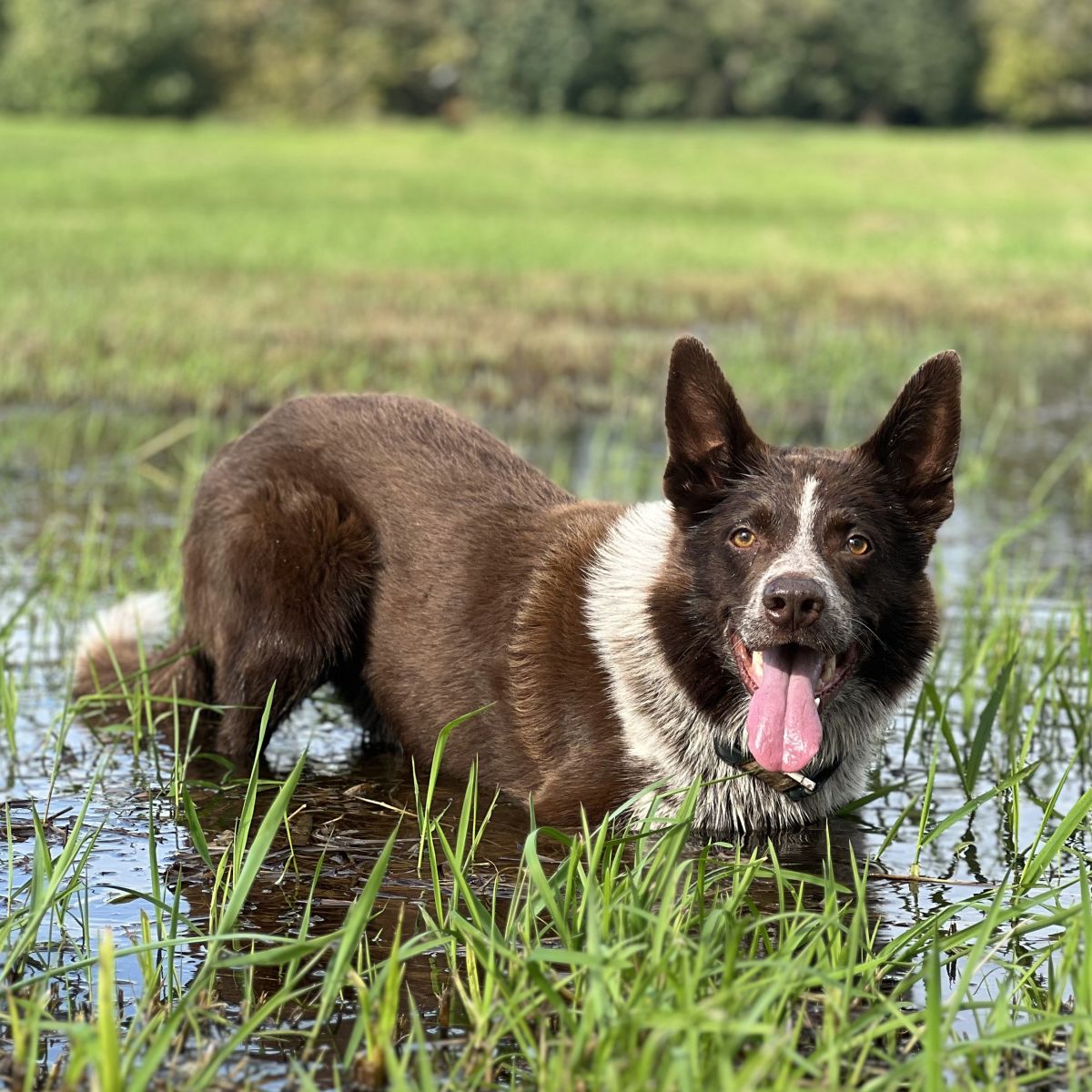
Hi! I’m Steffi. I am a biologist and a big time dog nerd. You are curious about coat color genetics? You’ve come to the right place! Read more.

